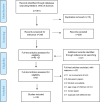Health visiting teams and children's oral health: a scoping review
- PMID: 36496377
- PMCID: PMC9741786
- DOI: 10.1186/s12903-022-02611-6
Health visiting teams and children's oral health: a scoping review
Abstract
Background: Recent policies have recommended early-life interventions to prevent caries. The four nations of the UK each have a national universal children's health programme, through which health visitors and their wider team (HVTs) promote health in the early years. HVT visits offer an opportunity to support parents to improve their child's oral health. A scoping review was conducted to provide a descriptive synthesis of the current literature related to the role of HVTs in improving the oral health of children 0-5 years old and to identify significant gaps for future research. This review informed the feasibility study of the First Dental Steps Intervention, a targeted health visitor-led infant oral health intervention in England.
Methods: Electronic database searches for peer-reviewed literature were performed using Medline via Ovid and Web of Science (1946-2021). The quality of included intervention studies was assessed using the Effective Public Health Practice Project tool. Additionally, a grey literature search was conducted (key organisations, bibliographic and thesis databases, forwards and backwards citation, Google).
Results: Thirty-nine publications, published between 1980 and 2021, were included. The majority of included papers were from the UK. The quality of intervention studies (n = 7) ranged from weak to strong. Thematic analysis identified the following themes: (1) professional knowledge, education, and training; (2) involvement of HVs in the delivery of oral health interventions; (3) effectiveness of interventions; (4) perspectives of HVs providing oral health advice and acceptability; and (5) barriers and facilitators to promoting oral health. The grey literature search identified 125 sources. HVT involvement was reported in a variety of source types: reports, guidance documents, evaluations, reviews, and training resources. HVTs were involved in oral health by providing oral health packs, brushing and oral health advice, registration and attendance, oral health training, risk assessment, and referral to dental services.
Conclusion: The current literature suggests that HVTs are well placed to improve children's oral health. Facilitators and barriers are encountered by HVTs in promoting oral health which should be considered by commissioners. There is a need for future high-quality studies that address the inadequacies found and provide further evidence of the effectiveness of HVT's oral health interventions.
Keywords: Children; Health visiting teams; Health visitors; Oral health; Review.
© 2022. Crown.
Conflict of interest statement
The authors declare that they have no competing interests.
Figures
Similar articles
-
Beyond the black stump: rapid reviews of health research issues affecting regional, rural and remote Australia.Med J Aust. 2020 Dec;213 Suppl 11:S3-S32.e1. doi: 10.5694/mja2.50881. Med J Aust. 2020. PMID: 33314144
-
Strategies used for childhood chronic functional constipation: the SUCCESS evidence synthesis.Health Technol Assess. 2024 Jan;28(5):1-266. doi: 10.3310/PLTR9622. Health Technol Assess. 2024. PMID: 38343084 Free PMC article.
-
"Strong Teeth": an early-phase study to assess the feasibility of an oral health intervention delivered by dental teams to parents of young children.BMC Oral Health. 2021 May 17;21(1):267. doi: 10.1186/s12903-021-01608-x. BMC Oral Health. 2021. PMID: 34001087 Free PMC article.
-
"Strong Teeth": the acceptability of an early-phase feasibility trial of an oral health intervention delivered by dental teams to parents of young children.BMC Oral Health. 2021 Mar 20;21(1):138. doi: 10.1186/s12903-021-01444-z. BMC Oral Health. 2021. PMID: 33743641 Free PMC article.
-
School dental screening programmes for oral health.Cochrane Database Syst Rev. 2019 Aug 8;8(8):CD012595. doi: 10.1002/14651858.CD012595.pub3. Cochrane Database Syst Rev. 2019. Update in: Cochrane Database Syst Rev. 2022 Jul 27;7:CD012595. doi: 10.1002/14651858.CD012595.pub4. PMID: 31425627 Free PMC article. Updated.
Cited by
-
Current Status and Family Factors Influencing Caries in the Deciduous Teeth of Children 3-6 Years of Age in Families Residing in Rural Heishanzui Township.Oral Health Prev Dent. 2024 Apr 23;22:145-150. doi: 10.3290/j.ohpd.b5245819. Oral Health Prev Dent. 2024. PMID: 38652287 Free PMC article.
-
Designing a Smartphone Application for Detection of Oral Bite Force Using Artificial Intelligence.Int Dent J. 2025 Aug;75(4):100799. doi: 10.1016/j.identj.2025.03.008. Epub 2025 May 3. Int Dent J. 2025. PMID: 40319773 Free PMC article.
-
First Dental Steps intervention: feasibility study of a health visitor led infant oral health improvement programme.BMC Oral Health. 2025 Jul 3;25(1):1087. doi: 10.1186/s12903-025-06154-4. BMC Oral Health. 2025. PMID: 40611145 Free PMC article.
References
-
- Department of Health. Healthy lives, healthy people: Improving outcomes and supporting transparency. In: Department of Health London 2012.
-
- Inagaki LT, de Almeida Prado DG, Iwamoto AS, Miori Pascon F, Pereira Neto JS, Duarte Gavião MB, Puppin-Rontani RM. Interdisciplinary approach between dentistry and speech-language pathology in treatment of children with early childhood caries. Revista CEFAC. 2015;17:595–603.
-
- Llena C, Leyda A, Forner L, Garcet S. Association between the number of early carious lesions and diet in children with a high prevalence of caries. Eur J Paediatr Dent. 2015;16(1):7–12. - PubMed
Publication types
MeSH terms
LinkOut - more resources
Full Text Sources
Medical




